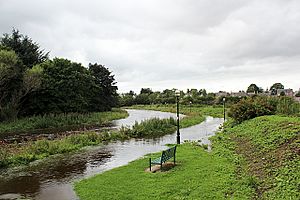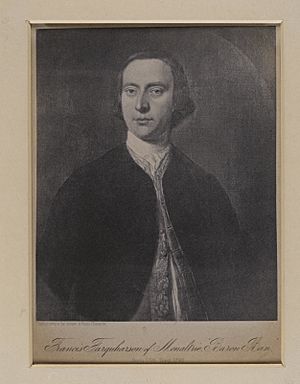Lewis Gordon (Jacobite) facts for kids
Quick facts for kids
Lord Lewis Gordon
|
|
|---|---|

Lewis Gordon, aged 13, from a portrait by John Alexander
|
|
| Born | 1724 Huntly, Aberdeenshire |
| Died | 15 June 1754 Montreuil, Seine-Saint-Denis |
| Allegiance | |
| Rank | Lieutenant (British); Colonel (Jacobite) |
| Unit | Lord Lewis Gordon's Regiment |
| Battles/wars | Jacobite Rising of 1745 |
Lord Lewis Gordon (born 1724 – died 1754) was a Scottish nobleman and naval officer. He is best known for his role in the Jacobite rising of 1745. During this time, Charles Edward Stuart, also known as Bonnie Prince Charlie, made him a leader in Aberdeenshire and Banffshire.
During the rising, Lord Lewis Gordon helped gather many men for the Jacobite army. These men often came from the lands of his brother, the Duke of Gordon. The northern areas of Scotland provided a large part of the Jacobite army. After the rising failed, he escaped to France. He died there in 1754.
Contents
Early Life and Career
Lewis Gordon was the fourth son of Alexander Gordon, 2nd Duke of Gordon. His mother was Lady Henrietta Mordaunt. Because he was a younger son, he used the title 'Lord'. His father had supported the Jacobites in an earlier uprising in 1715. However, his father later received a pardon from the government.
Lewis Gordon joined the Royal Navy. He became a Lieutenant in 1744. He served on a ship called HMS Dunkirk.
The 1745 Jacobite Rising
In May 1745, Lewis Gordon left his naval post. This happened around the same time that Charles Stuart began his plans for a Scottish uprising. Gordon traveled to Scotland. On October 16, 1745, he promised his loyalty to Charles at Holyrood.
Some people believed Gordon joined the Jacobites because he met many old friends who were also involved. They thought it was easy to convince a young man like him. He was also offered an important role. He would become the Lord Lieutenant of Aberdeenshire and Governor of Aberdeen and Banff.
However, his support for the Jacobites might have also been a way for his brother, the Duke of Gordon, to have influence with both sides. The Duke was one of the biggest landowners in Scotland. Lewis Gordon's mother knew about his plans and approved. His brother, the Duke, claimed to be ill. He did not officially forbid his tenants from joining the rebellion until November.
Lord Lewis Gordon's Regiment
Charles Stuart made Gordon a member of his 'Council of War'. Then he sent him north to gather men from the Gordon family lands. In this part of Scotland, tenants still had a duty to provide military service when asked. Gordon was good at recruiting. He used strong methods to get men to join. One person wrote that Gordon was "putting in to prisson [sic] all who are not willing to Rise." He even threatened to burn property if people refused. This quickly made people join.
Other officials of the Duke of Gordon also helped gather soldiers. They used similar methods. An early unit was raised by John Gordon of Glenbucket. Another unit, called the 'Enzie' battalion, joined the main army in Edinburgh on October 4.
Lord Lewis Gordon's own regiment had three main groups. The 'Aberdeen' group was mostly volunteers from Aberdeen. The 'Strathbogie' group was made up of men who were required to serve. The 'Mar' group was mostly Highlanders. Gordon's regiment became one of the largest in the Jacobite army. It had over 800 men.

Once his regiment was strong, Gordon organized the defense of Aberdeen. Then he moved to fight government forces. He led one part of the Jacobite troops. Another part was led by Avochie. However, a French officer named Major Cuthbert seemed to be in charge of the actual fighting.
Cuthbert and Gordon defeated the government forces at the Battle of Inverurie. This happened on December 23, 1745. Gordon then joined the main Jacobite army in Perth. His regiment was at the Battle of Falkirk in January. There, the Jacobites won a victory against the government army.
At the Battle of Culloden in April 1746, Gordon's regiment was held in reserve. They helped stop an attempt to surround the Jacobite army. They suffered many losses during this. After the Jacobite defeat, the regiment retreated in an orderly way. Lewis Gordon is thought to have hidden for several months. Then he took a ship from Peterhead and escaped to France.
Life After 1745
After the rebellion, the government passed a law against those who fought for the Jacobites. Lewis Gordon's name was on this list. In 1747, a French official wrote a report about the 1745 rising. He said that Lewis Gordon was "full of courage and ambition."
In 1749, Gordon was one of six Scots chosen for a special group in Paris. This group looked at requests for money from Scottish refugees. These refugees needed help from King Louis XV of France. Around the same time, a French government note said that Gordon did not get along well with Charles Stuart. It also mentioned he had some health issues. A British report from 1752 said that Gordon had secretly visited Scotland.
It is believed he had a wife and daughter, but not much more is known about them.
His name is remembered in a popular Jacobite song called "Lewie Gordon."


